Pro leg: Meg Fisher’s custom carbon bike prosthesis
This article originally appeared on Velo News
Two weeks ago, Meg Fisher became the first -- and only -- para-cyclist to complete the LeadBoat Challenge.
The 39-year-old from Missoula, Montana was in the saddle for nearly 26 hours to finish the 105-mile Leadville Trail 100 MTB race and the 142-mile SBT GRVL Black course, back-to-back.
While Fisher was one of dozens of riders to tackle the monster weekend of riding, she was the only one to do it with one anatomical leg and one prosthesis. Suffice it to say, I was less interested in profiling Fisher’s LeadBoat bikes -- a Cannondale Topstone and Scalpel -- because in my opinion, the real equipment standout is her leg.
For the past 20 years, Fisher has been living as a below-the-knee amputee, after a car accident resulted in severe damage to her left ankle. In those two decades, she has medaled at two Olympic games, won 11 paracyling world championships, become a doctor of physical therapy, and more recently, become both an elite athlete and an advocate in the burgeoning gravel scene.
Fisher has achieved all of the above using various iterations of a prosthetic lower left leg, most of which were not ideal for competing at a high level of sport.
That is, until her friend Brian Williams made her current riding leg, a decidedly DIY affair that he stitched together using an intimate knowledge of working with carbon, experience as a bike fitter, and an understanding of his friend’s unique mechanics.
Frankenleg
First, a basic tenant of prosthetics -- not all limbs are created equal.
After Fisher’s accident, she was fitted for a “walking leg,” which is to say, a prosthesis for everyday use. However, Fisher had more than “everyday use” on her mind -- the former collegiate tennis player had already decided that she was returning to sport, and she very quickly took up triathlon, and then cycling exclusively.
That first leg wasn’t ideal for running -- and definitely not for riding -- but “you don't know what you don't know,” Fisher says.
What Fisher later learned is that the walking leg was designed to “play with compliance and try and return some level of energy. A riding leg, on the other hand, should have zero movement.”
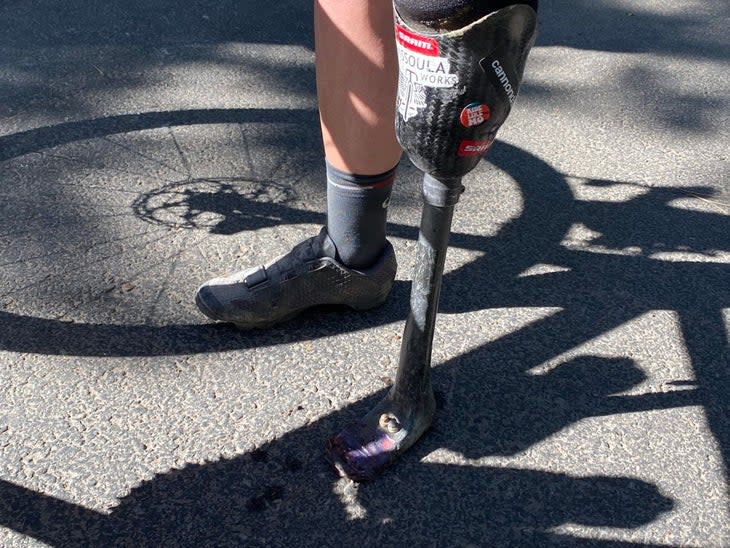
Nevertheless, Fisher muscled her way through life with that prosthesis, becoming increasingly competitive on the bike in the process. She joined the USA Cycling national team and qualified for the 2012 Paralympic Games. However, she was also suffering. She even enrolled in PT school because she wasn’t sure she could carry on as a professional athlete, the pain was that bad.
“Basically I used my walking leg in cycling shoe for seven years,” Fisher says. “A prosthetist said we could make a more specialized foot but it wouldn’t be covered by insurance. He said we could take used parts and try and make something.”
Thus was born “Frankenleg.”
“Frankenleg stopped my leg from hurting so I could go to the Paralympics,” Fisher says. “Before that I thought I'd have to stop riding.”
Fisher’s prosthetist, Dr Brian Rotter, had done a good job making a cycling-specific leg out of used parts, and Fisher used it for many years with fewer problems than she’d had before. She competed in the Paralympics and won world championships.
But again, Fisher didn’t have anything to compare it to.
“I didn’t know it could be any different,” she says. “I'd seen people with cool legs. But I had been like, ‘whatever you give me I'll take it and walk it and ride and do the best I can.'”
Meanwhile, Fisher was living in Missoula, training and working as a PT, when she befriended Brian Williams -- the two worked together at Missoula Bicycle Works.
While Williams never set out to make a prosthesis for Fisher, he also didn’t think his friend needed to settle.
“He was like, ‘no we can do this better,'” Fisher says.
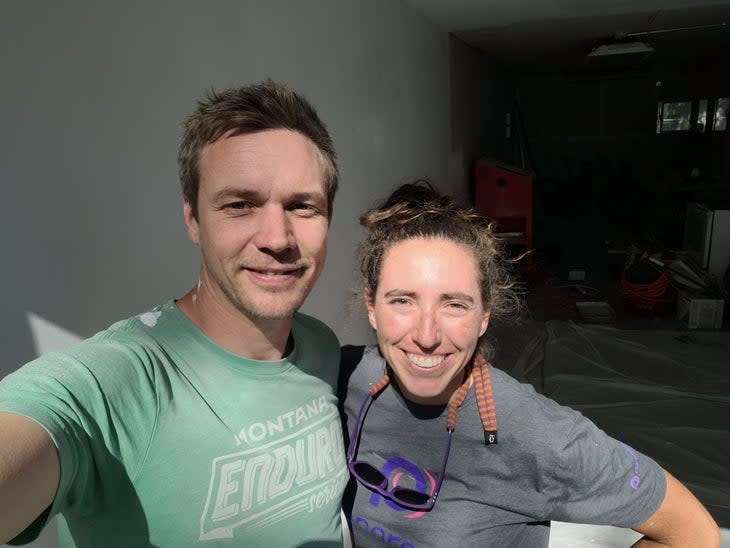
‘He geeked out and went to town.’
Fisher and Williams were friends for years before he had the thought to make her an improved riding prosthesis. In addition to working at the bike shop, Williams was designing and building saddles and geeking out on bike fit and ergonomics. Fisher was riding one of his saddles, so he’d spent some time adjusting her fit.
It was during a fit session that Williams made his first discovery about how Fisher was compensating on the bike.
“At some point were were looking at it, and I realized the biggest issue for her was range of motion from right to left,” he says. “We came up with the idea of using shorter crank arm on the amputated side to make up for the lack of lever on her foot, and ankle flexion.”
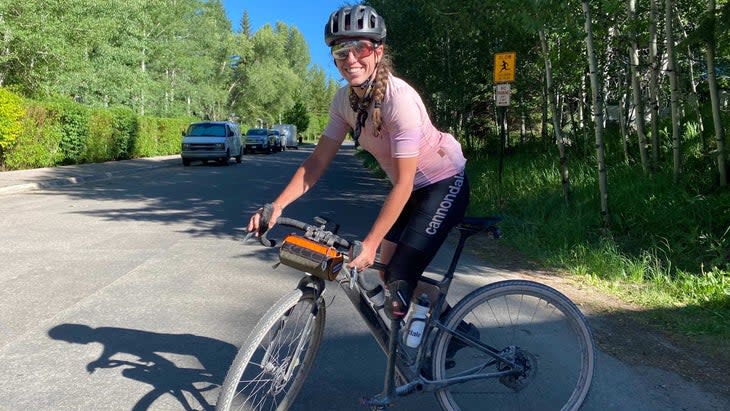
That discovery parlayed into wanting to design a new leg for Fisher.
“Her existing leg was decent, but by changing the cleat offset and length we could make it better,” Williams says. “So I came up with the length and offsets and design of it.
“She needed a leg and I knew how to work with carbon and it seemed like a cool thing to do.”
Fisher’s recollection is this:
“Brian said he could make Frankenleg better because it was heavy. He took it home, made sketches on paper, made measurements, took the angle -- it's not a pirate peg leg, the angle is important. He had me ride and played with the cleat position. Had me sit on a trainer, experimented with angle of pylon and where to place the cleat.
“He geeked out and went to town.”
The Brian Williams edition
Williams has no formal training as a prosthetist and says that his friendship with Fisher, as well as his experience as a bike fitter and saddle maker, informed the process of designing her leg.
The main objective was to make something lighter and more efficient than the Frankenleg while also using the same general design and, most importantly, Fisher’s custom socket.
With a lower limb prosthesis, the part that touches the limb is the socket. Everything below is considered the ‘prosthetic foot.’ The shaft is called a pylon. Rather than reinvent Fisher’s entire leg, Williams set about to improve the prosthetic foot.
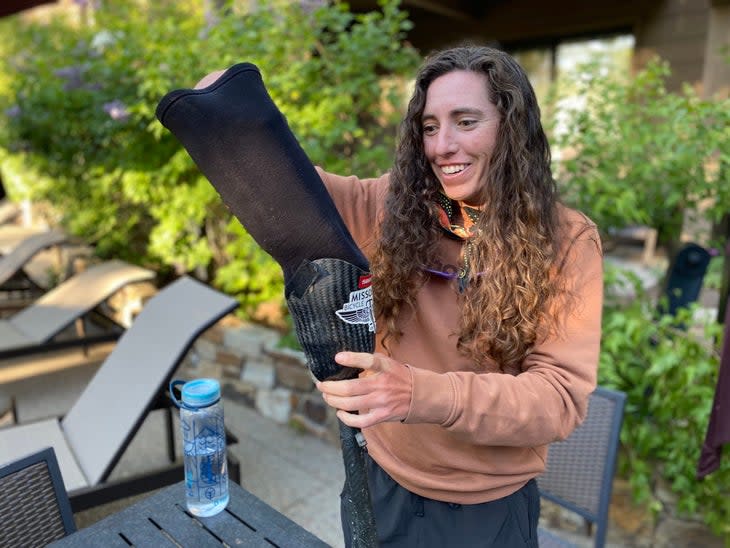
“If you do a really high end leg, they'd probably integrate the socket into the leg,” he says. “Meg’s socket fits on with a vacuum sleeve, so it’s more complicated. The idea was to make a lighter version because the previous one was basically an aluminum shaft, it was quite heavy
“The typical socket she uses for day to day life has tubular fitting with a clamp so any tube with the right diameter can fit in there. So all she needs is an Allen key and can swap out the leg real quick. It was a way to use the existing socket that a prosthetist made that's custom to her leg.”
Williams took cues from bicycle framebuilding in material selection and in how he went about bonding parts together.
For the pylon, he looked at seat posts of a similar diameter to decide what size carbon tube to use, then “bumped it up on wall thickness for good measure.”
To make sure that pressure from the clamp where the pylon fit into the socket didn’t crush the tube, Williams bonded in an aluminum and fiberglass insert.
“Kinda like a bonded-in star nut on a carbon fork,” he says. “Some carbon forks on bikes have a bonded-in star nut that also serves as a reinforcement against clamping pressure from the stem.”
From the top down, the rest of the leg is built in same way that tube-to-tube carbon frames are built, Williams says. He molded a carbon foot plate and bonded it to the carbon tube, then filleted it and wrapped it with extra unidirectional carbon to the support the joint.
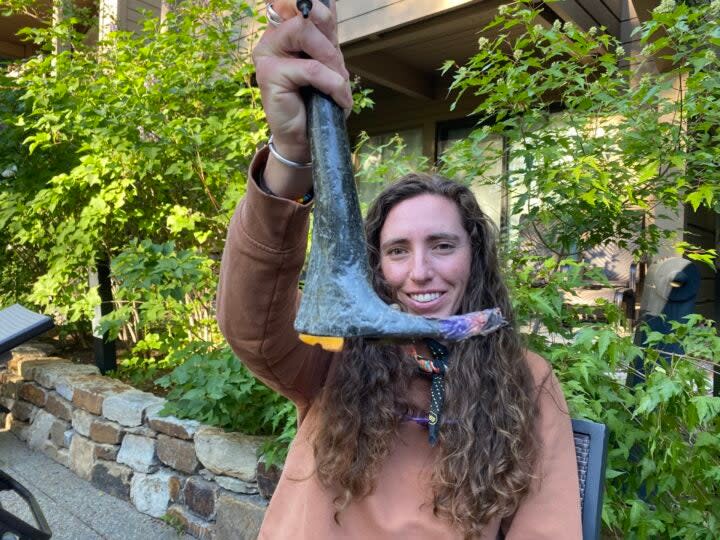
The final product was half the weight of Fisher’s previous leg, and “clearly very strong. Because it’s her leg, I didn’t want it to break,” Williams says.
Nevertheless, Williams believes he over-engineered certain aspects and thinks he could make it lighter. Fisher, who says she trusts Williams “implicitly,” could probably use a new leg, as she’s put hundreds of thousands of miles on the current one. During Unbound, an epic slog through mud and grit wore away at the tip of the foot.
What’s currently standing in the way of Williams and Fisher collaborating on a version 2.0 of her riding leg? Time, or rather a lack thereof. They’re both too busy working -- and riding bikes.
For exclusive access to all of our fitness, gear, adventure, and travel stories, plus discounts on trips, events, and gear, sign up for Outside+ today.

